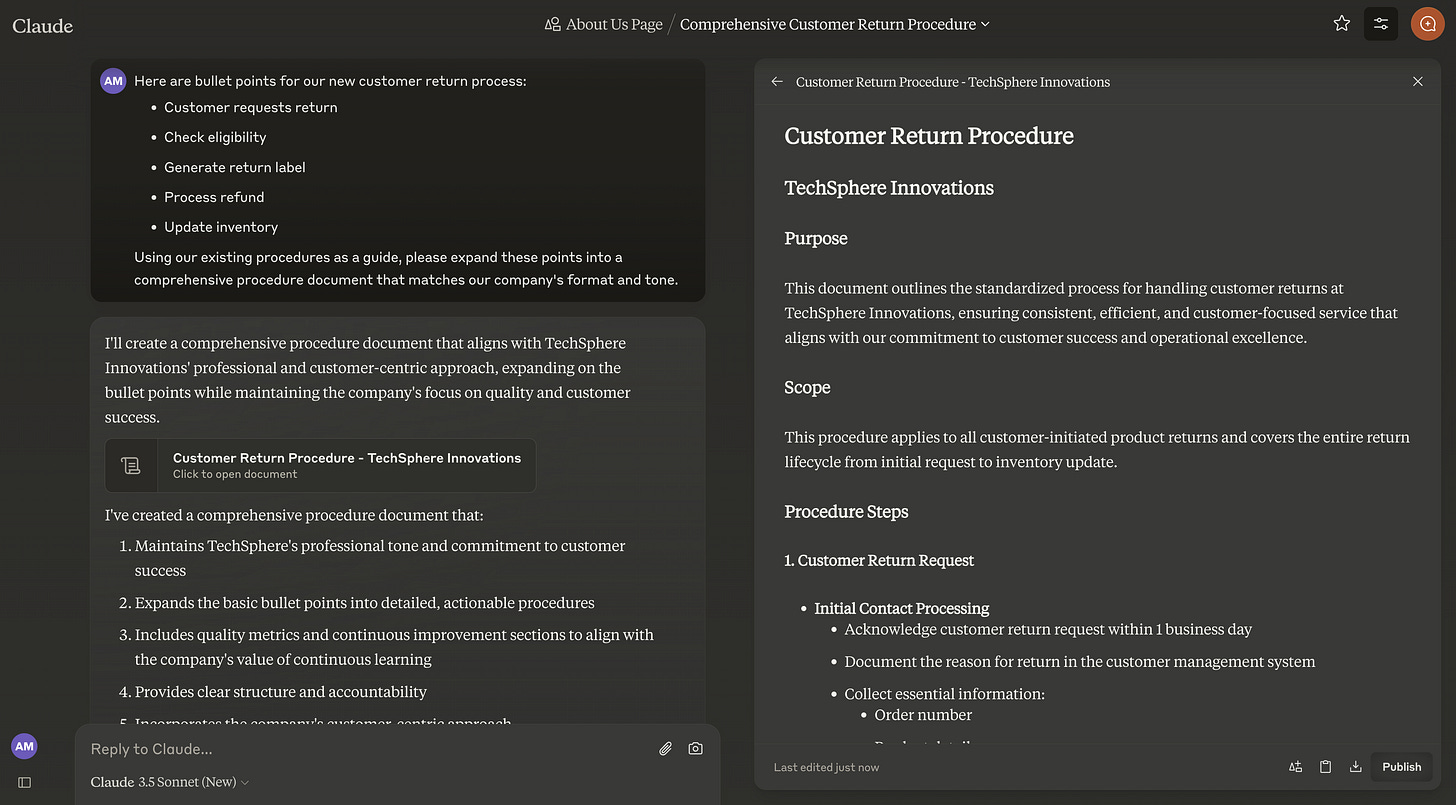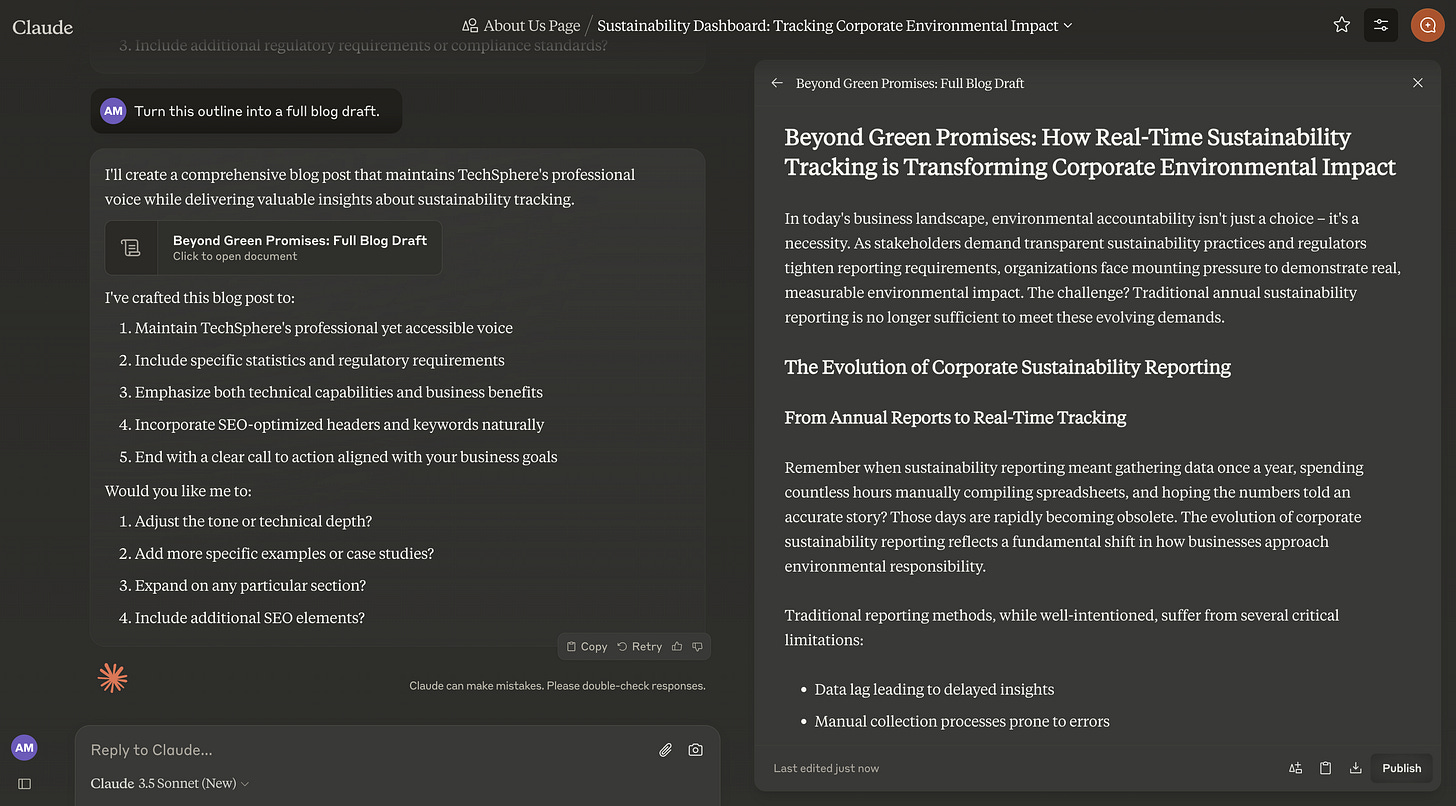A Practical Guide to Implementing Claude Projects with Company Docs
Step-by-step instructions for implementing Claude Projects with your company docs.
Every enterprise faces a common challenge: vast amounts of valuable knowledge trapped within countless documents, spreadsheets, and internal wikis. From product specifications to customer service protocols, this documentation represents years of accumulated expertise. Yet, most organizations struggle to effectively leverage this knowledge, leading to:
Repeated searches across multiple platforms for basic information
Inconsistent responses to customer inquiries
Knowledge silos between departments
Time wasted recreating existing documentation
Valuable insights lost in outdated or forgotten files
Difficulty onboarding new employees due to scattered information
Reduced efficiency caused by duplicate efforts and redundant data storage
Inability to quickly locate critical information during urgent decision-making
Lack of standardized processes for knowledge management
Poor integration of knowledge into daily workflows, limiting innovation.
This is an area where AI-powered document integration through Claude Projects can help. This tool can transform static documentation into dynamic knowledge bases that your entire organization can efficiently access and utilize. By integrating your enterprise documentation with Claude, you can:
Enable instant, accurate answers from your company's collective knowledge
Ensure consistent responses aligned with company policies and procedures
Break down departmental knowledge silos
Reduce time spent searching for information
Keep organizational knowledge current and accessible
Streamline onboarding by providing new employees with easy access to key information
Enhance decision-making with quick retrieval of critical insights
Automate routine queries, freeing up employees for higher-value tasks
Improve collaboration by centralizing information and making it readily available
Increase productivity by integrating knowledge into everyday workflows
In this guide, I’ll provide practical, step-by-step instructions for implementing Claude Projects with your company docs. You'll learn how to prepare your documents, set up the platform, and create effective AI assistants that leverage your organization's unique knowledge base.
Preparing Your Documentation
Before diving into platform implementation, proper document preparation is crucial for success. Here's how to organize and optimize your documentation for AI integration.
Start by creating a clear hierarchical structure for your documentation:
Core Categories: Establish main document categories such as:
Company Policies & Procedures
Product Documentation
Customer Service Guidelines
Technical Specifications
Training Materials
Subcategories: Create logical subcategories based on departments, products, or functions. For example, subcategories for the Technical Specifications category could include:
IT Specifications
Software Architecture & Design
API Documentation
System Requirements
Integration Guides
Security Protocols
Performance Benchmarks
Version Control: Implement a clear versioning system to maintain document accuracy
Pro Tip: Use a consistent naming convention that includes the category, date, and version number (e.g., "ProductSpec_Widget123_2024_v2.1")
File Format Considerations
AI platforms work best with certain file formats. Prioritize:
PDF files for final documentation
Word documents for regularly updated content
Plain text files for technical documentation
Excel spreadsheets and CSV files for structured data
HTML files for web-based content
Important: Convert any scanned documents to searchable PDFs using OCR (Optical Character Recognition) software to ensure AI readability.
Creating a Sustainable Knowledge Management System
Implement these practices for long-term success:
Central Repository: Create a single source of truth for all documentation
Google Drive works well for its simplicity and widespread adoption. Other options include Sharepoint, Confluence, OneDrive, or Notion for more structured collaboration and documentation management.
Ensure proper folder structures and access permissions
Document Registry: Maintain a master spreadsheet or database tracking:
Document locations
Last update dates
Document owners
Review schedules
Update Protocols: Establish clear procedures for:
Document ownership
Document updates
Review cycles
Archival processes
New document creation
Tips for Maintaining Document Quality
Follow these guidelines to ensure your documentation remains AI-friendly:
Content Structure
Use clear headings and subheadings
Include tables of contents for longer documents
Maintain consistent formatting throughout
Writing Quality
Use clear, concise language
Avoid jargon unless necessary for your industry
Include definitions for technical terms
Update any outdated information promptly
Regular Maintenance
Schedule quarterly document reviews
Remove or archive obsolete content
Update links and references
Verify all information remains accurate
Metadata Management
Include relevant tags and keywords
Add clear document descriptions
Update modification dates
List primary stakeholders
By following these preparation guidelines, you'll create a robust foundation for implementing both Claude Projects and Custom GPTs. Well-organized, properly formatted documentation ensures your AI assistants can accurately access and utilize your organization's knowledge base.
Claude Projects Implementation Guide
Claude Projects can transform how you leverage your documentation, but getting started requires careful planning and setup. First, you'll need a Claude Pro subscription, which costs $20 per month. Once subscribed, access claude.ai and log in with your email to begin creating your first project.
The platform offers a generous 200K token context window – equivalent to roughly 500 pages of text. This substantial capacity allows you to upload significant portions of your documentation, but it requires strategic planning to use effectively.
Setting Up Your First Project Workspace
Creating your first project workspace is straightforward but requires thoughtful consideration. Navigate to the Projects tab from your dashboard and select "Create Project." Rather than jumping straight into uploading documents, take time to thoughtfully name your project and write a detailed description. This step might seem basic, but clear naming conventions and comprehensive descriptions will prove invaluable as your usage scales.
As you manage more projects and team members, complexity will increase. Consistent naming and thorough descriptions ensure better organization, faster retrieval, and improved collaboration. Establishing this structure early saves time, minimizes confusion, and supports efficient scaling as your workload grows.
For your first project, choose a focused scope rather than attempting to include all company documentation. For example, you might start with a company “About Us” page, a product documentation for a single product line, or customer service guidelines for one department. This focused approach allows you to test and refine your implementation strategy before scaling to larger initiatives.
Building and Organizing Knowledge Bases
Think of your knowledge base as a living library rather than a static repository. Start by uploading your core documentation – the essential documents your team references most frequently. This might include product specifications, service guidelines, or company policies. As you become comfortable with the system, gradually expand your knowledge base with supporting materials.
The key to successful knowledge base building lies in maintaining a clear organizational structure. Create logical sections within your project that mirror your existing document hierarchy. This familiar structure helps team members understand where to find information and makes maintenance more manageable. Think of it as a map to your knowledge ‘territory,’ guiding users directly to the needed information. It ensures quick orientation for new team members, reduces onboarding time, and keeps updates consistent as the knowledge base grows.
Best Practices for Document Uploads
Document upload success depends heavily on proper preparation. Before uploading, ensure your documents are machine-readable and free from unnecessary formatting. This includes removing excessive use of fonts, colors, borders, embedded images, and complex tables that can disrupt text extraction and processing. Simplifying the formatting helps maintain consistency and improves accuracy during analysis. Large documents should be broken into logical segments, ideally keeping individual files under 100 pages to maintain system performance.
When uploading documents, use the "Add Content" button within your project and pay attention to the storage percentage indicator. After each upload, take a moment to verify that Claude can successfully access and interpret the information by asking test questions related to the uploaded content.
Maximizing Context Window Usage
The 200K token context window is a powerful feature, but it requires strategic management. Think of it as premium real estate – every token should earn its place. Focus on including high-value, frequently accessed information while removing redundant content. Keep critical information concise and well-structured for efficient retrieval. The risk is to add unnecessary text simply because the token ‘space’ allows it. Overfilling the context can lead to ambiguity, reduced clarity, and potential conflicts in interpretation. Prioritize quality over quantity, as too much content can dilute focus and make critical information harder to find.
Consider implementing a regular review process to monitor token usage and optimize your content. This might involve consolidating related information, removing unnecessary formatting, or restructuring content for more efficient retrieval. The goal is to maximize the value of every token while maintaining comprehensive coverage of essential information.
Let’s look at what Claude can do when you give it a document containing company information and ask it to write an “About Us” page. The document contains a few paragraphs of: “Our Mission,” “Our Vision,” “What We Do,” “Our Values” and “Why Choose Us.””
Common Pitfalls and Solutions
Experience shows that most organizations face similar challenges when implementing Claude Projects. The most common issue is overcrowding – trying to fit too much information into a single project. Instead of creating one massive knowledge base, consider breaking your content into focused projects based on departments, products, or functions.
Another frequent challenge is maintaining consistent updates. Combat this by establishing clear ownership and regular review cycles for all uploaded content. Assign specific team members responsibility for different sections of your knowledge base and schedule regular reviews to ensure information stays current. Periodic reviews of documents and processes will ensure that the information remains accurate, relevant, and aligned with current needs. Regular updates help identify outdated content, correct errors, and refine workflows, improving overall efficiency and effectiveness.
Performance issues can often stem from poorly optimized documents. If you notice slow response times, examine your document structure and format. Sometimes, simply reorganizing content or removing unnecessary formatting can significantly improve performance.
Leveraging Claude Projects for Content Generation
While Claude Projects excels at organizing and retrieving information, a lot of power lies in its ability to generate and transform content using your knowledge base. By combining your uploaded documentation with Claude's language capabilities, you can automate and enhance numerous content creation tasks.
Example 1: Converting Bullet Points to Procedures
One of the most time-consuming tasks in any organization is creating detailed procedure documents. When launching new processes, teams often start with basic bullet points but struggle to expand them into comprehensive guides. With your existing SOPs uploaded to Claude, you can ensure new procedures match your company's established format, terminology, and level of detail.
Example 2: Expanding Product Descriptions
Marketing teams often receive technical specifications and need to transform them into compelling product descriptions. Claude can help bridge this gap by incorporating technical details while maintaining your brand's voice and marketing style.
Example 3: Marketing Copy Variations
When launching new products or features, marketing teams need to create numerous variations of announcements for different platforms. With your brand guidelines and product information in Claude's knowledge base, you can quickly generate on-brand variations that highlight different aspects of your offering.
Example 4: Blog Development and Content Planning
One of Claude's most powerful applications is helping to plan, outline, and draft blog content that aligns with your existing content strategy. By uploading your content style guide, past blog posts, and key company documentation, Claude can help maintain consistent voice and messaging while generating fresh perspectives.
Here's an effective two-step approach:
Step 1: Generate an SEO-optimized outline
First, ask Claude to create a structured outline in your project space:
Step 2: Expand the approved outline
Once you've reviewed and refined the outline, you can have Claude develop it into a full draft:
Each of these examples demonstrates how Claude can transform your static documentation into dynamic content while maintaining consistency with your organization's voice and standards. The key is providing clear instructions and ensuring your knowledge base contains the necessary context and guidelines.
[Note: Each of these prompts assumes relevant documentation has been uploaded to the Claude Project. The actual outputs will depend on your specific documentation and guidelines.]
Creating Specialized Project Workspaces
Different departments have unique needs when it comes to accessing and utilizing company documentation. The sales team might need quick access to product specifications and pricing guides, while customer service requires detailed troubleshooting procedures and policy documents. Rather than creating a single massive knowledge base, consider developing specialized Claude Projects for each department.
For example, a technical support department might have a project focused on:
Product technical documentation
Known issue databases
Resolution workflows
System specifications
Meanwhile, the marketing team's project could focus on brand guidelines, campaign histories, and market research. This specialization ensures faster response times and more relevant information retrieval.
Security and Compliance Considerations
Security in Claude Projects requires a multi-layered approach. Start by conducting a thorough audit of your documentation to identify different sensitivity levels. Implement a classification system that clearly marks documents as public, internal, confidential, or restricted.
Consider creating separate projects for different security levels rather than mixing sensitive and general information. This separation provides an additional layer of protection against accidental exposure of sensitive data.
For regulated industries, maintain detailed logs of:
Who accesses each project
What documents are uploaded or removed
When changes are made to the knowledge base
How information is being used
Measuring Success and Optimization
Performance Monitoring
Success with Claude Projects should be measured both quantitatively and qualitatively. Track key metrics such as:
Query Response Time: Monitor how quickly Claude provides answers to user queries. Slower response times might indicate the need for knowledge base optimization.
Accuracy Rates: Regularly sample responses to verify information accuracy. Document any instances of incorrect or incomplete information to identify areas needing improvement.
Usage Patterns: Analyze which documents and types of information are accessed most frequently. This insight helps prioritize content updates and optimize organization.
User Adoption Strategies
Successful implementation depends heavily on user adoption. Start with a core group of power users who can help refine the system and serve as advocates. These early adopters can provide valuable feedback on usability and help identify areas for improvement.
Create documentation that shows users how to effectively query the system. Include real-world examples of successful queries and demonstrate how to ask follow-up questions for more detailed information.
Continuous Improvement Techniques
Improvement should be an ongoing process driven by user feedback and performance data. Implement regular feedback sessions where users can share their experiences and suggestions. Use this information to guide improvements in both content organization and query handling.
Monitor failed queries or instances where users couldn't find needed information. These represent opportunities to improve either the knowledge base content or the way information is structured.
Future Scalability Considerations
As your use of Claude Projects grows, consider how to scale effectively:
Storage Management: Implement an archival strategy for outdated or rarely accessed documents to maintain optimal performance.
Knowledge Base Evolution: Plan for regular content audits and reorganization as your documentation grows and evolves.
Team Structure: Consider appointing dedicated knowledge base managers as the system scales, ensuring consistent maintenance and optimization.
Training Programs: Develop comprehensive training materials for new users as your organization grows and more teams begin utilizing Claude Projects.
Remember that scaling isn't just about adding more content – it's about maintaining quality and usability as your system grows. Regular assessment of your implementation's effectiveness will help guide strategic decisions about expansion and optimization.
The Bottom Line
Implementing Claude Projects effectively can transform how your organization or personal brand leverages its collective knowledge. By following the guidelines outlined in this guide – from proper document preparation to advanced optimization strategies – you can create a dynamic, accessible knowledge base that serves your entire organization. While the initial setup requires careful planning and ongoing maintenance, the results are worth the investment: faster access to information, more consistent responses, and better utilization of your company's documentation, especially companies with fewer resources. As AI technology continues to evolve, organizations that master these implementation strategies will find themselves well-positioned to adapt and scale their knowledge management capabilities.
Keep a lookout for the next edition of AI Uncovered!
Follow on Twitter, LinkedIn, and Instagram for more AI-related content.














